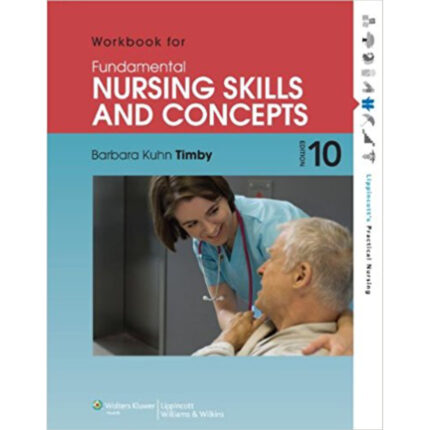Reading Understanding And Applying Nursing Research 5th Edition By James – Test Bank
Chapter 11: Principles of Measurement
Answer Section
MULTIPLE CHOICE
1.ANS:1
Chapter: Principles of Measurement
Chapter Learning Objective: 2. Discuss the issue of reliability and distinguish among the various types.
Page: 247
Heading: Internal Consistency Reliability
Integrated Processes: Nursing Process
Client Need: Safe and Effective Care Environment
Cognitive Level: Comprehension
Concept: Evidence-based practice
Difficulty: Moderate
Feedback
1 This is correct. An estimate of reliability based on the average correlation among items within a test is called internal consistency reliability.
2 This is incorrect. When the average correlation among items within a test is measured, it is called internal consistency reliability.
3 This is incorrect. Test-retest reliability is measured when a researcher assesses a group of individuals twice, separated by a period of time.
4 This is incorrect. An estimate of reliability based on the average correlation among items within a test is called internal consistency reliability.
PTS: 1 CON: Evidence-based practice
2.ANS:3
Chapter: Principles of Measurement
Chapter Learning Objective: 4. Discuss the relationship between reliability and validity
Page: 250
Heading: Validity
Integrated Processes: Nursing Process
Client Need: Safe and Effective Care Environment
Cognitive Level: Comprehension
Concept: Evidence-based practice
Difficulty: Easy
Feedback
1 This is incorrect. A high level of reliability does not ensure high validity.
2 This is incorrect. An instruments data must be reliable if they are to be valid; however, high reliability is an insufficient condition for high validity.
3 This is correct. A high level of reliability is necessary, but not sufficient for high validity.
4 This is incorrect. A high level of reliability has a significant effect on validity.
PTS: 1 CON: Evidence-based practice
3.ANS:2
Chapter: Principles of Measurement
Chapter Learning Objective: 2. Discuss the issue of reliability and distinguish among the various types.
Page: 247
Heading: Internal Consistency Reliability
Integrated Processes: Nursing Process
Client Need: Safe and Effective Care Environment
Cognitive Level: Knowledge
Concept: Evidence-based practice
Difficulty: Easy
Feedback
1 This is incorrect. Cronbach’s alpha measures internal consistency.
2 This is correct. Cronbach’s alpha is used to determine internal consistency.
3 This is incorrect. Internal consistency is determined by using Cronbach’s alpha.
4 This is incorrect. Cronbach’s alpha is a statistical procedure used to assess internal consistency.
PTS: 1 CON: Evidence-based practice
4.ANS:1
Chapter: Principles of Measurement
Chapter Learning Objective: 2. Discuss the issue of reliability and distinguish among the various types.
Page: 245
Heading: Test-Retest Reliability
Integrated Processes: Nursing Process
Client Need: Safe and Effective Care Environment
Cognitive Level: Knowledge
Concept: Evidence-based practice
Difficulty: Easy
Feedback
1 This is correct. Test-retest reliability focuses on the stability of an instrument.
2 This is incorrect. Validity is the accuracy of an instrument, whereas test-retest reliability focuses on the stability of an instrument
3 This is incorrect. Test-retest reliability focuses on the stability of an instrument.
4 This is incorrect. The stability of an instrument is determined by the test-retest reliability.
PTS: 1 CON: Evidence-based practice
5.ANS:3
Chapter: Principles of Measurement
Chapter Learning Objective: 1. Compare and contrast the four types of scales of measurement.
Page: 241
Heading: Ordinal
Integrated Processes: Nursing Process
Client Need: Safe and Effective Care Environment
Cognitive Level: Application
Concept: Evidence-based practice
Difficulty: Easy
Feedback
1 This is incorrect. In addition to having all the characteristics of nominal and ordinal scales, interval levels of measurement have an equal interval size based on an actual unit of measurement.
2 This is incorrect. Categories in ratio scales are different, ordered, and separated by a constant unit of measurement, and ratio scales have an absolute zero.
3 This is correct. A rating scale from severe to low is an ordinal level of measurement. It specifies the order of items without specifying how far apart they are.
4 This is incorrect. Nominal measurements classify subjects into two or more categories, such as more or less. Data simply shows the frequency of the subject.
PTS: 1 CON: Evidence-based practice
6.ANS:3
Chapter: Principles of Measurement
Chapter Learning Objective: 2. Discuss the issue of reliability and distinguish among the various types.
Page: 245
Heading: Reliability
Integrated Processes: Nursing Process
Client Need: Safe and Effective Care Environment
Cognitive Level: Knowledge
Concept: Evidence-based practice
Difficulty: Easy
Feedback
1 This is incorrect. Test-retest is a type of reliability that tests the consistency of measurements.
2 This is incorrect. Interrater reliability is measured by the degree of agreement among raters.
3 This is correct. Content is not a type of reliability.
4 This is incorrect. Internal consistency is a type of reliability that measures the consistency of the instruments.
PTS: 1 CON: Evidence-based practice
7.ANS:4
Chapter: Principles of Measurement
Chapter Learning Objective: 3. Discuss the issue of validity and distinguish among the various types.
Page: 251-252
Heading: Criterion-Related Validity
Integrated Processes: Nursing Process
Client Need: Safe and Effective Care Environment
Cognitive Level: Knowledge
Concept: Evidence-based practice
Difficulty: Easy
Feedback
1 This is incorrect. Concurrent validity and predictive validity are types of criterion-related validity evidence.
2 This is incorrect. Predictive validity and concurrent validity are types of criterion-related validity evidence.
3 This is incorrect. Internal consistency is a type of reliability measurement.
4 This is correct. Both concurrent validity and predictive validity are types of criterion-related validity evidence.
PTS: 1 CON: Evidence-based practice
8.ANS:2
Chapter: Principles of Measurement
Chapter Learning Objective: 1. Compare and contrast the four types of scales of measurement.
Page: 244
Heading: Errors Associated With Measurement
Integrated Processes: Nursing Process
Client Need: Safe and Effective Care Environment
Cognitive Level: Comprehension
Concept: Evidence-based practice
Difficulty: Easy
Feedback
1 This is incorrect. Various approaches to measuring aspects of the same thing can be useful.
2 This is correct. Whenever data are collected, some amount of error is always encountered.
3 This is incorrect. Present day behavior predicts future behavior.
4 This is incorrect. Testing and assessment benefit society.
PTS: 1 CON: Evidence-based practice
9.ANS:1
Chapter: Principles of Measurement
Chapter Learning Objective: 2. Discuss the issue of reliability and distinguish among the various types.
Page: 245
Heading: Test-Retest Reliability
Integrated Processes: Nursing Process
Client Need: Safe and Effective Care Environment
Cognitive Level: Comprehension
Concept: Evidence-based practice
Difficulty: Easy
Feedback
1 This is correct. Test-retest reliability is determined by measuring consistency of scores over time.
2 This is incorrect. Split-half reliability is determined by measuring the consistency of scores obtained from two equivalent halves of the same examination.
3 This is incorrect. Internal consistency reliability is measured by the degree of consistency with which a test measures a single construct/concept.
4 This is incorrect. Interrater reliability is determined by the measure of degree of agreement between two or more scores.
PTS: 1 CON: Evidence-based practice
10.ANS:3
Chapter: Principles of Measurement
Chapter Learning Objective: 3. Discuss the issue of validity and distinguish among the various types.
Page: 250
Heading: Content Validity
Integrated Processes: Nursing Process
Client Need: Safe and Effective Care Environment
Cognitive Level: Comprehension
Concept: Evidence-based practice
Difficulty: Moderate
Feedback
1 This is incorrect. Construct validity refers to how well an instrument measures an intended hypothetical concept.
2 This is incorrect. Criterion-related validity refers to how well an instrument measuring a particular concept compares with a criterion, providing more quantitative evidence on the accuracy of the instrument.
3 This is correct. Content validity refers to how well the particular sample of behaviors used to measure a characteristic reflects the entire domain of behaviors that constitutes that characteristic.
4 This is incorrect. Face validity refers to how well a test is subjectively viewed as covering the content it measures.
PTS: 1 CON: Evidence-based practice













Reviews
There are no reviews yet.